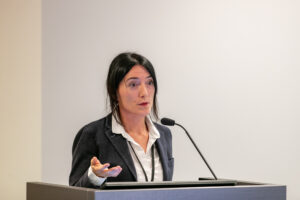The Final Event: Closing Remarks
CLOSING REMARKS: THE END OR A NEW BEGINNING, Sara Garavelli, CSC – IT Center for Science & EOSC Association Board of Directors
The event closed with a keynote speech by Sara Garavelli, from CSC-IT Centre for Science and EOSC Association Board of Directors.
Sara was challenged to answer the question: Is this event marking the closure of EOSC Nordic project or the start of a new beginning?
In order to answer the question, Garavelli analysed some of the activities performed by the project: EOSC-Nordic did a landscape analysis of the status of Open science policies in different Nordic and Baltic countries. Why? Because this information was not publicly accessible. To do this task, EOSC-Nordic tapped into their existent network, connecting with policymakers. As a result of this activity, in addition to having planted seeds for long-term collaborations with the policymakers in the region, the analysis is now available to all users in the tripartite pages of the eosc.eu website with the plan of having the Mandated Organisations of the EOSC Association or the EOSC national structures maintaining this information updated over the next years. This was possible thanks to a strict collaboration with the Members States representatives and the EOSC Association and as a result of the project a sustainable and updated source of information on policy is in place.
Another activity that the project was supposed to perform was testing the financial model of EOSC in the region. As the model is not existing yet the EOSC Nordic partners consulted the co-chairs of the EOSC Association Financial Sustainability Task Force to understand how the project could put its experts at the service of the Task Force and the EOSC Partnership. The resulting request was to provide the TF with a report documenting how different Nordic collaborations are financed and procured.
Sara Garavelli also mentioned other activities implemented, such as the FAIRification of repositories, the FAIR training activities done in the project and the new initiative launched by NeiC of the affiliate projects as a way to sustain this after the project. She also praised ETAIS for their plan to maintain the regional catalogue built during the project for the next 2 years. These are just a few examples of activities that the EOSC Nordic project did that had already a direct contribution to EOSC or will have after the end of the project.
This is why the answer to the question Is this event marking the closure of EOSC Nordic project or the start of a new beginning? is that this event is indeed marking the end of an era, the era of doing things the H2020 way where each individual project was looking at its Grant Agreement objectives only without taking into consideration the bigger picture.
EOSC implementation relies both on the EC funding projects and in-kind contributions of organisations. In order to be successful these two parties need to work in sync, avoiding duplication of effort and divergent routes. EOSC-Nordic has been a pioneer in approaching the Grant Agreement activities within a bigger picture, the picture of the EOSC co-programmed partnership. “All the Nordic and Baltic countries have committed to the ERA action number 1; thanks to the SRIA there is a common EOSC vision and strategic roadmap, the EOSC Association is setting up mechanisms for facilitating and making more impactful the work of the projects, at regional level we have the NeiC affiliate projects” – she said to the participants.
Without going outside its mandate the project was able to dedicate its effort to the priorities identified by the EC and the EOSC Association and this is why its results will be lasting beyond its contractual end.
This is the way to move forward. Ending the old era. And starting a new beginning towards an operational EOSC.

Image: Sara Garavelli. Photo by Gertrud Alatare.